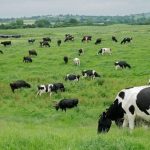
For dairy farmer Robert Brokenshire, the use of technology is more than just an opportunity to boost productivity – it represents a commitment to adopting energy-efficient practices to ensure the sustainability of his farm, and of the planet.
Brokenshire’s embrace of technology is fast becoming the norm in Australia’s agribusiness sector, where modern techniques, machinery and digital tools are being used to boost farming yields, profitability, and productivity, while also helping to reduce the industry’s carbon footprint.
“Agriculture recognises it has its part to play in emissions reduction,” says Brokenshire who, along with his son Nick, has operated the Roslyn Amdena Jerseys dairy farm at Mt Compass in South Australia, for over 40 years.
“Dairy farming is ahead of most industry targets, and our family quickly realised we had an obligation, a responsibility, when it comes to emissions reductions,” says Brokenshire, a long-term BankSA customer.
This year, the Brokenshires completed a major infrastructure upgrade with the installation of a state-of-the-art rotary milking system, which will help to boost productivity, improve environmental outcomes, and support the health of their 400 Jersey cows.
“The changes we’re making have a high technology energy-efficiency focus, while also prioritising animal welfare and health,” says Brokenshire, who is also a former South Australian MP.
According to Dairy Australia, 10 per cent of total agriculture emissions is attributable to the dairy industry, and the largest source of on-farm emissions comes from enteric methane (56 per cent) – a by-product of the cow’s natural digestive process. With farming already seeing the negative impacts of extreme weather events due to climate change, the Australian Dairy Industry Council has committed to a 30 per cent reduction of emissions intensity by 2030, compared to 2015.
“Australia is well in line with its targets and has one of the lowest carbon footprints in the world when it comes to dairy farming,” says Brokenshire. “Agriculture has grasped opportunities in both science and technology, and dairying is focused very much on sustainability and regenerative agriculture.”
Westpac earlier this month set a target to reduce its financed emissions to the agriculture sector as part of its commitments under the Net-Zero Banking Alliance. In dairy, the bank is targeting a 10 per cent reduction in Scope 1 land management emissions intensity by 2030, relative to a 2021 baseline.
Westpac will work with its customers and industry groups in the sector on ways to meet the target, said Anthony Miller, Westpac chief executive, business and wealth.
Investments into the sector are among the biggest dairy farmers have ever seen, Brokenshire says.
“Through the feasibility study we conducted, and upgrades to the farm, we wanted to showcase how productivity and sustainability go hand in hand. Existing technology can improve farm returns while minimising impact on the environment, our people, and animals.”
Brokenshire’s view that productivity and sustainability can – and should – be achieved concurrently is a belief held across the industry.
Greenhouse gas emissions represent an inefficiency in dairy systems according to Dairy Australia, with the loss of gases into the atmosphere indicating a loss of energy that could be directed towards production.
The upgrades to Roslyn Amdena Jerseys in particular are conducive to better enteric methane management and will see the farm increasing energy efficiency through its high-tech machinery, balanced feed rations, improved breeding, and better timed and targeted fertiliser applications.
Ultimately, a climate-conscious, more productive farm is a no-brainer for the Brokenshires.
“The legacy of this farm can be traced back 4 generations,” he says.
“Using the latest technology and best management practices to drive more sustainable systems on our farm, while still prioritising the welfare of our jersey cows – that’s rewarding. It means the farm can thrive for generations to come.”
For more information on Westpac’s commitments under the Net-Zero banking alliance, click here (PDF 537KB).
























